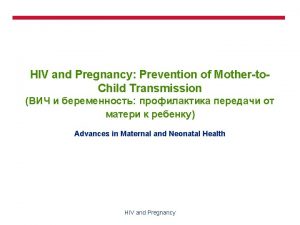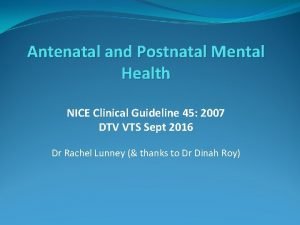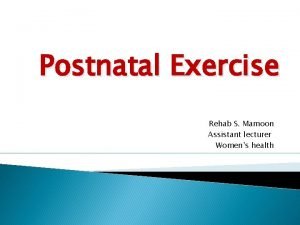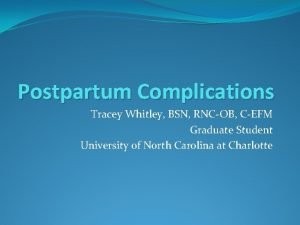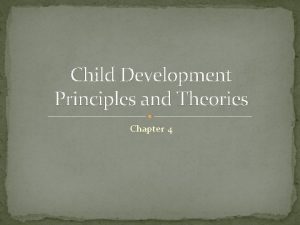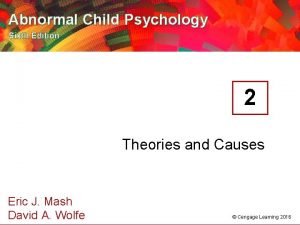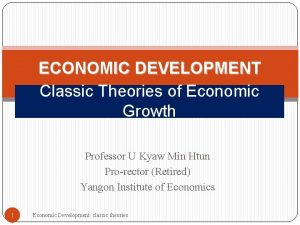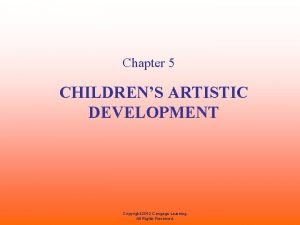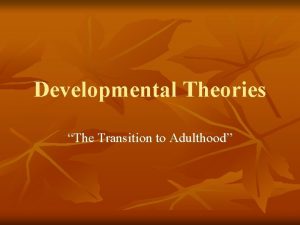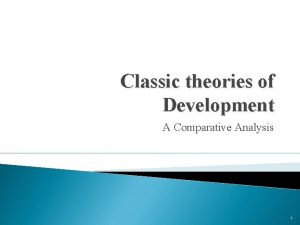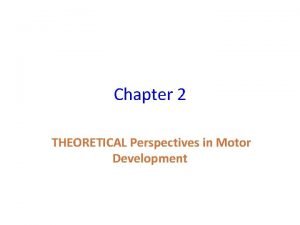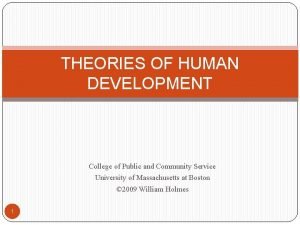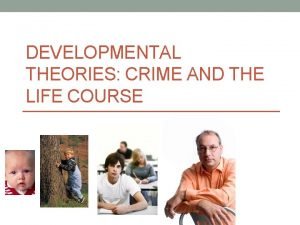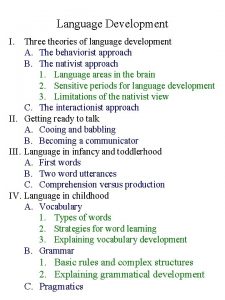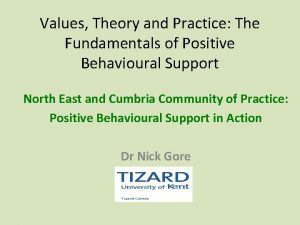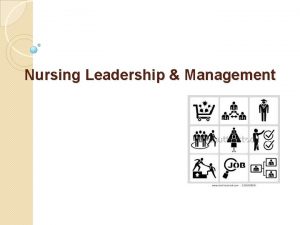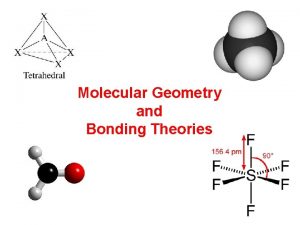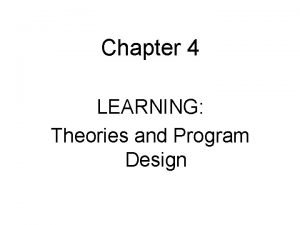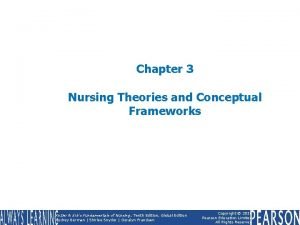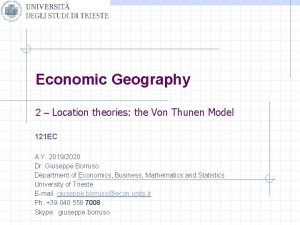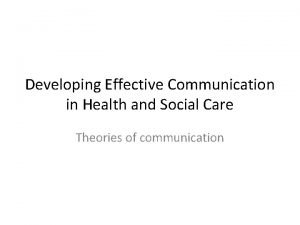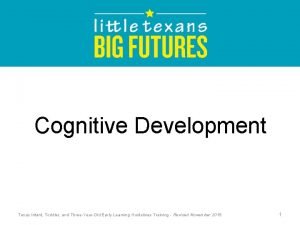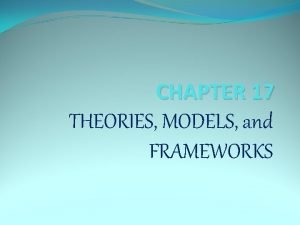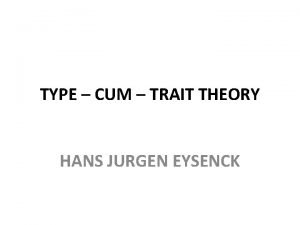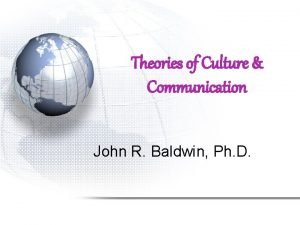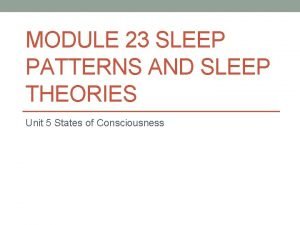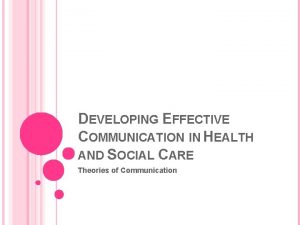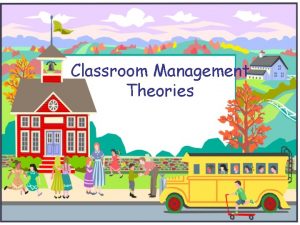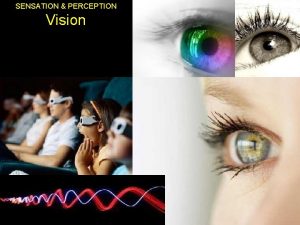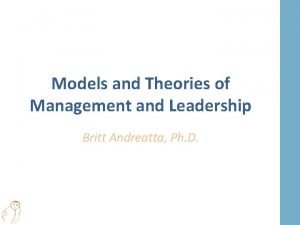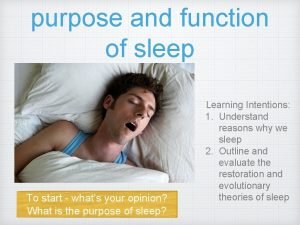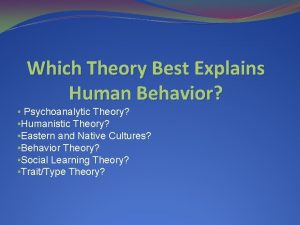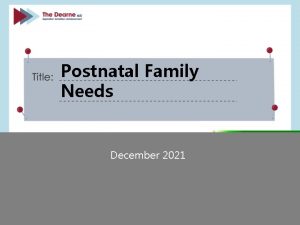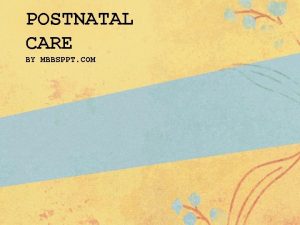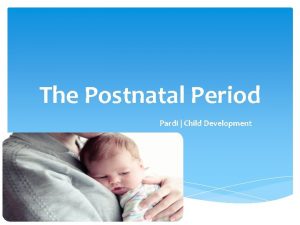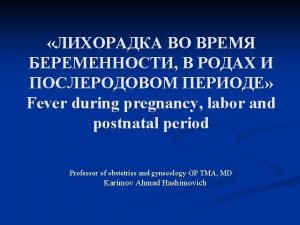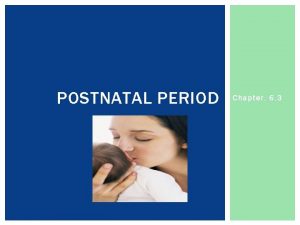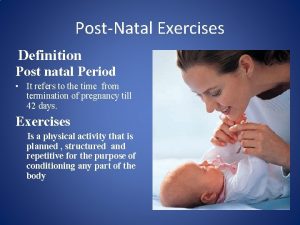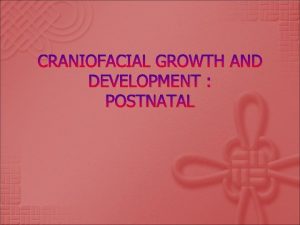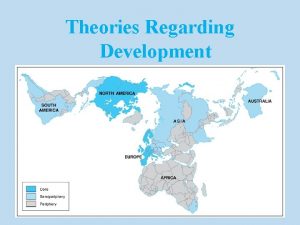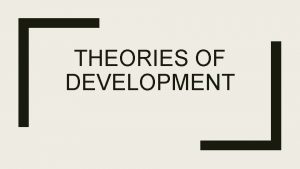PostNatal Period of Development and Theories of Development
































































- Slides: 64

Post-Natal Period of Development and Theories of Development

Basic Processes of Development • Maturation – Biological process of systematic physical growth – Experience plays a role in specific contexts • Children change dramatically from birth to adulthood

Stage Theories of Development • Stages – series of abrupt changes from one period to another – – All children must pass through in same order – More qualitative than quantitative (such as child mastering physical properties of object)

Stages of the Lifespan • • • Infancy (birth – 2 weeks) Babyhood (2 weeks – 2 years) Early Childhood (2 -7 years) Late Childhood (7 -12 years) Puberty (10 -16 years) Adolescence (12 -21 years) Young Adulthood (21 -35 years) Middle Adulthood (35 – 50 years) Late Adulthood / Old Age (50 above)

Infant Abilities • Infants are born with immature visual system – can detect movement and large objects • Other senses function well on day 1 – will orient to sounds – turn away from unpleasant odors – prefer sweet to sour tastes • Born with a number of reflex behaviors

Infant Reflexes • Rooting—turning the head and opening the mouth in the direction of a touch on the cheek • Sucking—sucking rhythmically in response to oral stimulation • Grasping—curling the fingers around an object

Social and Personality Development • Temperament--inborn predisposition to consistently behave and react in a certain way • Attachment-- emotional bond between infant and caregiver

Quality of Attachment • Parents who are consistently warm, responsive, and sensitive to the infant’s needs usually have infants who are securely attached • Parents who are neglectful, inconsistent, or insensitive to infant’s needs usually have infants who are insecurely attached

Language Development • Noam Chomsky asserts that every child is born with a biological predisposition to learn language “universal grammar” • Motherese or infant directed speech-style of speech used by adults (mostly parents) in all cultures to talk to babies and children

Language Development • Infant preference for human speech over other sounds – before 6 months can hear differences used in all languages – after 6 months begin to hear only differences used in native language • Cooing—vowel sounds produced 2– 4 months • Babbling—consonant/vowel sounds between 4 to 6 months • Even deaf infants coo and babble

Language Development MONTH 2 4 10 12 24 24+ Speech Characteristic Cooing vowel sounds Babbling consonant/vowel Babbling native language sounds One-word stage Two-word stage Sentences

Early Childhood • Growth is less explosive and rapid than during infancy – Lasts 2 to 7 years of age – Cognitive development *Symbolic thinking, language used *egocentric thinking *imagination / experience grow

Early Childhood • Emotional and social development – Most notable changes in peer relationships and types of play • Solitary play • Parallel play • Cooperative play

Cooperative play Parallel play Solitary play

Young Children’s Vocabulary • Comprehension vocabulary-words that the infant or child understands • Production vocabulary--words that the infant or child understands and can speak

Gender Role Development • Gender—cultural, social, and psychological meanings associated with masculinity or femininity • Gender roles—various traits designated either masculine or feminine in a given culture • Gender identity—A person’s psychological sense of being male or female • Between ages 2 -3 years, children can identify themselves and other children as boys or girls. The concept of gender or sex, is, however, based more on outward characteristics such as clothing.

Gender Differences • Toddler girls tend to play more with dolls and ask for help more than boys • Toddler boys tend to play more with trucks and wagons, and to play more actively • After age 3 years we see consistent gender differences in preferred toys and activities • Children are more rigid in sex-role stereotypes than adults

Social Learning Theory Gender roles are acquired through the basic processes of learning, including reinforcement, punishment, and modeling

Gender Schema Theory • Gender-role development is influenced by the formation of schemas, or mental representations, of masculinity and femininity • Children actively develop mental categories of masculinity and femininity and categorize these into gender categories or schemas • Trucks are for boys and dolls are for girls is an example of a gender schema

Late Childhood • Lasts from 7 to 12 years of age – Characterized by slow physical growth – Important cognitive changes occur – Conservation and reversibility – Child decenters – allows conservation problems to be solved; learns some matter changes shape but not volume

Late Childhood • Emotional and social development – Child enters with close ties to parents – Peer relationships become increasingly important • Friendship is more important, last longer • Cliques or groups formed, mostly same sex • Terms boyfriend and girlfriend have little meaning at this stage

Piaget’s Theory of Cognitive Development • Jean Piaget (1896– 1980) Swiss psychologist who became leading theorist in 1930 s • Piaget believed that “children are active thinkers, constantly trying to construct more advanced understandings of the world” • Cognitive development is a stage process

Piaget’s Approach • Primary method was to ask children to solve problems and to question them about the reasoning behind their solutions • Discovered that children think in radically different ways than adults • Proposed that development occurs as a series of ‘stages’ differing in how the world is understood

Piaget’s Developmental Theory • Identified 4 stages of cognitive development – Sensorimotor stage – infant experiences world in sensory information and motor activities – Preoperational stage – children sometimes think illogically by adult standards – Concrete operational stage – increased abilities – Formal operational stage – use of full adult logic

Sensorimotor Stage (birth – 2) • Information is gained through the senses and motor actions • Child perceives and manipulates but does not reason • Symbols become internalized through language development • Object permanence is acquired

Object Permanence • The understanding that objects exist independent of one’s actions or perceptions of them • Before 6 months infants act as if objects removed from sight cease to exist – Can be surprised by disappearance/reappearance of a face (peek-a-boo)

Piaget Preoperational Stage (2– 7 years) • • • Emergence of symbolic thought Egocentrism Lack of the concept of conservation Concrete Operational (7– 12 years) • • • Increasingly logical thought Classification and categorization Less egocentric Conservation No abstract or hypothetical reason Formal Operational Stage (age 12 – adulthood) • • • Hypothetico-deductive reasoning Emerges gradually Continues to develop into adulthood

Summary of Piaget’s Cognitive Development Theory Birth to 2 Sensorimotor yrs Uses senses and motor skills, items known by use; Object permanence 2 - 7 yrs Symbolic thinking, language used; egocentric thinking, imagination/ experience grow, child de-centers Logic applied, objective/rational interpretations; conservation, numbers, ideas, classifications Thinks abstractly, hypothetical ideas; ethics, politics, social/moral issues explored Pre-operational 7 - 12 yrs Concrete operational 12 yrs onwards Formal operational

Adolescence • Transition stage between late childhood and early adulthood • Sexual maturity is attained at this time • Puberty--attainment of sexual maturity and ability to reproduce • Health, nutrition, genetics play a role in onset and progression of puberty

Social Relationships • Parent-child relationship is usually positive • May have some periods of friction • Peers become increasingly important • Peer influence may not be as bad as most people think. Adolescents tend to have friends of similar age, race, social class, and with same religious beliefs.

Adolescent Development • Physical development – Puberty becomes production of sex hormones – Primary sex characteristics appear • Females – menarche: menstruation, ovulation – Secondary sex characteristics appear • Females – breasts, pubic hair, wider hips • Males – testes and penis growth, facial and pubic hair, broadened shoulders

Adolescence • Cognitive development – Formal operations stage entered • Ability to use abstract concepts • Shift to stage varies among individuals; some never reach this stage, others reach it in early adulthood – Piaget’s classic experiment with weights

Piaget’s Balance Test - task: make the weight times the distance equal on both sides of center 4 -yr-old 7 -yr-old 5 kg A 10 -yr-old 5 kg C 5 kg B 14 -yr-old 10 kg 2 kg D 8 kg

Adolescence • Adolescent egocentrism – Imaginary audience – everyone is watching – Personal fable – belief that s/he is unique – Hypocrisy – okay for one to do it but not another – Pseudostupidity – use of oversimplified logic • Social development – Time of drifting or breaking away from family

Adolescence • Emotional development – G. Stanley Hall – time of storm and stress – Most adolescents are happy, welladjusted – Areas of problems • Parent-child conflicts • Mood changes - self-conscious, awkward, lonely, ignored • Risky behavior - aggression, unprotected sex, suicide, use of substances or alcohol

Erikson’s Life-Span Development Theory n n n Development proceeds in stages Each stage is characterized by a psychosocial challenge or crisis Stages reflect the motivation of the individual

Erikson’s Eight Stages of Human Development 8 - Integrity vs. despair 7 - Generativity vs. stagnation 6 - Intimacy vs. isolation 5 - Identity vs. identity confusion 4 - Industry vs. inferiority 3 - Initiative vs. guilt 2 - Autonomy vs. shame and doubt 1 - Trust vs. mistrust

Erikson’s Psycho-social Development Stages 1 - Trust vs. Mistrust 0– 1 years 2 - Autonomy vs. Shame and Doubt 1– 3 years 3 - Initiative vs. Guilt 3– 5 years Developed through consistent love and support Independence fostered by support and encouragement Developed by exploring and accepting challenges

Erikson’s Psycho-social Development Stages 4 - Industry vs. Inferiority 6 years–puberty Mastery comes from success and recognition 5 - Identity vs. Role Confusion Adolescence Exploration of different paths to attain a healthy identity 6 - Intimacy vs. Isolation Early adult years Form positive, close relationships with others

Erikson’s Human Psycho-social Development Stages 7 - Generativity vs. Stagnation Middle Adulthood Transmitting something positive to the next generation 8 - Integrity vs. Despair Late Adulthood Life review and retrospective evaluation of one’s past

Strategies for Erikson’s Stages of Development Initiative ü Encourage social play ü Have children assume responsibility ü Structure assignments for success Industry ü Nourish motivation for mastery ü Be tolerant of honest mistakes Identity ü Recognize that identity is multidimensional ü Encourage independent thinking ü Stimulate students to examine different perspectives

Summary of Erikson’s Theory Stage Psychosocial Crisis Age Psychosexual to age 2 Oral Trust vs. Mistrust Early 2 -3 Anal Play Age 3 -5 School Age 6 -12 Infancy / Babyhood Virtue Danger Hope Withdrawal Autonomy vs. Shame Will Compulsion/ Phallic Initiative vs. Guilt Purpose Inhibition Latency Industry vs. Inferiority Competence Inertia Genital Identity vs. Identity Confusion Fidelity Role Repudiation Adolescence 12 -18 Young 19 -35 Intimacy vs. Isolation Love Exclusivity Adulthood 35 -65 Generativity vs. Stagnati on Care Rejectivity Old Age after 65 Wisdom Disdain Integrity vs. Despair

Adult Development • Genetics and lifestyle combine to determine course of physical changes • Social development involves marriage and transition to parenthood • Paths of adult social development are varied and include diversity of lifestyles

Adulthood • Young adulthood through older adulthood – Developmental changes continue throughout adulthood: not a single phase of life – Taking on adult responsibilities in work and social relationships – Challenges: love, work, play continue changing

Adulthood • Physical development – Growth and strength in early adulthood, then slow process of decline afterwards • • Speed and endurance Vision and ability to see in weak lighting Hearing and detection of tones Taste – intact until later in life; men tend to lose hearing and taste earlier than women – Decline affected by health and lifestyles

Adulthood • Cognitive development – Continues throughout adulthood; some abilities improve while others decline • Fluid intelligence peaks in 20 s, declines therafter • Crystallized intelligence improves until 30 s; then declines slowly afterwards • Overall, individual rates vary depending on lifestyle and health

Adulthood • Emotional and social development – Many aspects of personality are fairly stable over time, and changes are predictable • On average, adults become – less anxious and emotional, socially outgoing, and creative • People become more dependable, agreeable, and accepting of life’s hardships • Gender differences lessen over time

Adulthood • Emotional and social development – Much disagreement about when and how changes occur during aging – differences between stages of infant/child development and adult development • Not all adults go through every stage • Order of stages can vary for individuals • Timing of stages not controlled by biological maturation

Stages of Adult Life • Early adulthood – Erikson • Intimacy versus isolation (17 to 45 years) – Levinson - Early adulthood has three stages • Entry into early adulthood (17 -28) • Age 30 transition (28 -33) • Culmination of early adulthood (to age 35) – Challenges of career, marriage, and parenthood

Middle Adulthood • Erikson – – Generativity versus stagnation (35 -60 years) • Taking stock of what one has, who s/he is • Some are happy, some are disappointed • Generativity – reaching out, not self-centered

Middle Adulthood • Levinson – four brief stages – – Midlife transition (early 40 s) Entry to middle adulthood stage (45 to 50) Age 50 transition Culmination of middle adulthood • Climactic – – Female sexual ability to reproduce declines – Not all adult development timed by social clock rather than biological clock

Late Adulthood • Old age as a time of poor health, inactivity, and decline is a myth • Activity theory of aging—life satisfaction is highest when people maintain level of activity they had in earlier years

Later Adulthood • Erikson (age 60 and onward) – Integrity versus despair • Looks back over life as a whole: satisfying existence or merely staying alive • Levinson devotes little to later years • Life expectancy dramatically increased as have conceptions of old age – many have healthy years after retirement – Second careers and activism launched

Causes of Aging • Biological – human body deteriorates • Psychological – Happy or unhappy aging – Social activity and slowed intellectual decline or disengagement and isolation – Maintain healthy or unhealthy lifestyle – Optimism linked to happier, healthier, longer life

Death and Dying • In general, anxiety about dying tends to decrease in late adulthood • Kubler-Ross stages of dying – – – Denial Anger Bargain Depression Acceptance

Kohlberg’s Theory of Moral Development • Assessed moral reasoning by posing hypothetical moral dilemmas and examining the reasoning behind people’s answers • Proposed six stages, each taking into account a broader portion of the social world

Levels of Moral Reasoning • Preconventional—moral reasoning is based on external rewards and punishments • Conventional—laws and rules are upheld simply because they are laws and rules • Postconventional—reasoning based on personal moral standards

Summary of Kohlberg’s Theory of Moral Development Level I: Preconventional moral reasoning Stage 1 “might Punishment/obedience makes right” orientation: self-interest Stage 2 “look out for number one” Stage 3 “good girl, Level II: Conventional nice boy” moral reasoning Stage 4 “law and order” Stage 5 “social Level III: contract” Postconventional moral reasoning Stage 6 “universal ethical principles” Instrumental/relativist orientation: quid pro quo Proper behavior for the social approval Proper behavior of the dutiful citizen, obey laws Mutual benefit to all, obey society’s rules Defend right/wrong, not just majority, all life is sacred (reflective)

Kohlberg’s Theory of Moral Development Theory into Practice Sam starts to get out of his seat to sharpen his pencil without permission. He stops because he realizes that if he does, others might also do so and this could result in disorder in the classroom. Because of this, he understands that it is his duty to follow the rules. Q: At which of Kohlberg’s stages of moral development is Sam functioning?

Kohlberg’s Theory of Moral Development Theory into Practice Sam starts to get out of his seat to sharpen his pencil without permission. He stops because he realizes that if he does, he will be punished. Q: At which of Kohlberg’s stages of moral development is Sam functioning? Explain.

Kohlberg’s Theory of Moral Development Theory into Practice Sam starts to get out of his seat to sharpen his pencil without permission. He stops because he realizes that if he does, it will displease his teacher. Q: At which of Kohlberg’s stages of moral development is Sam functioning? Explain.

Application of Psychology: Parenting • Parents play a key role in children’s lives – – Parenting and infant attachment Parenting and discipline style Effect in childrearing: Two-way street Common discipline mistakes • Lax parenting, verbosity, overreactivity, and reinforcement of inappropriate behavior – Sociocultural factors in parenting – Myth of the perfect parent – Day care, divorce, and parenting

Baumrind’s Parenting Styles • Authoritarian—value obedience and use a high degree of power assertion • Authoritative—less concerned with obedience, greater use of induction • Permissive—most tolerant, least likely to use discipline • Neglectful—completely uninvolved

Styles Baumrind: Three Parenting Style Authoritarian Permissive Authoritative Warmth low high Discipline strict high rare low moderate high low high Expected Maturity Communication: parent-child Communication: child-parent
 Antenatal intrapartum and postnatal
Antenatal intrapartum and postnatal Nice guidelines postnatal depression
Nice guidelines postnatal depression Crock lying
Crock lying Ergometrium
Ergometrium Tracey whitley novant health
Tracey whitley novant health Absolute refractory period and relative refractory period
Absolute refractory period and relative refractory period Is hyperpolarization the same as refractory period
Is hyperpolarization the same as refractory period Trustee period and royal period
Trustee period and royal period Difference between history and prehistory
Difference between history and prehistory Theories of growth and development
Theories of growth and development Child development principles
Child development principles Theories of normal and abnormal development
Theories of normal and abnormal development Cynthia lightfoot
Cynthia lightfoot Critical period vs sensitive period
Critical period vs sensitive period Critical/sensitive periods
Critical/sensitive periods Critical period vs sensitive period
Critical period vs sensitive period 1750s music
1750s music 29 electrons period 4
29 electrons period 4 Period of activism
Period of activism Stability period vs measurement period
Stability period vs measurement period Dualistic development thesis
Dualistic development thesis Kellogg drawing stages
Kellogg drawing stages Four theories of language development
Four theories of language development Levinson stages of development
Levinson stages of development Classic theories of development
Classic theories of development Motor development theories
Motor development theories Neoliberal theory
Neoliberal theory Theories of human development
Theories of human development Developmental theories
Developmental theories Three theories of language development
Three theories of language development Theories and values of positive practice
Theories and values of positive practice Management theories in nursing
Management theories in nursing Molecular geometry and bonding theories
Molecular geometry and bonding theories Freudian fixation
Freudian fixation Permit easy reversal of actions
Permit easy reversal of actions Firm based trade theory
Firm based trade theory Learning theories and program design
Learning theories and program design The living tree of nursing theories
The living tree of nursing theories Krashen chomsky
Krashen chomsky International marketing theories
International marketing theories Von thunen location theory
Von thunen location theory What is effective communication in health and social care
What is effective communication in health and social care Piagetian and information processing theories 8-18 months
Piagetian and information processing theories 8-18 months Nursing informatics theories, models and frameworks
Nursing informatics theories, models and frameworks Anomie definition sociology
Anomie definition sociology Cum
Cum Co culture definition communication
Co culture definition communication Module 16 sleep patterns and sleep theories
Module 16 sleep patterns and sleep theories Ch6n lewis structure
Ch6n lewis structure Demography ap human geography
Demography ap human geography Theories of international trade and investment
Theories of international trade and investment Theories of communication in health and social care
Theories of communication in health and social care Skinner model of discipline
Skinner model of discipline Difference between geocentric and heliocentric models
Difference between geocentric and heliocentric models Sensation
Sensation Management models and theories
Management models and theories Interpersonal attraction meaning
Interpersonal attraction meaning Educational theorists and their theories
Educational theorists and their theories Module 23 sleep patterns and sleep theories
Module 23 sleep patterns and sleep theories Module 23 sleep patterns and sleep theories
Module 23 sleep patterns and sleep theories Bonding theories
Bonding theories Compare and contrast trustee period and royal colony
Compare and contrast trustee period and royal colony Compare and contrast trustee period and royal colony
Compare and contrast trustee period and royal colony Sociological theory of crime
Sociological theory of crime Site:slidetodoc.com
Site:slidetodoc.com
